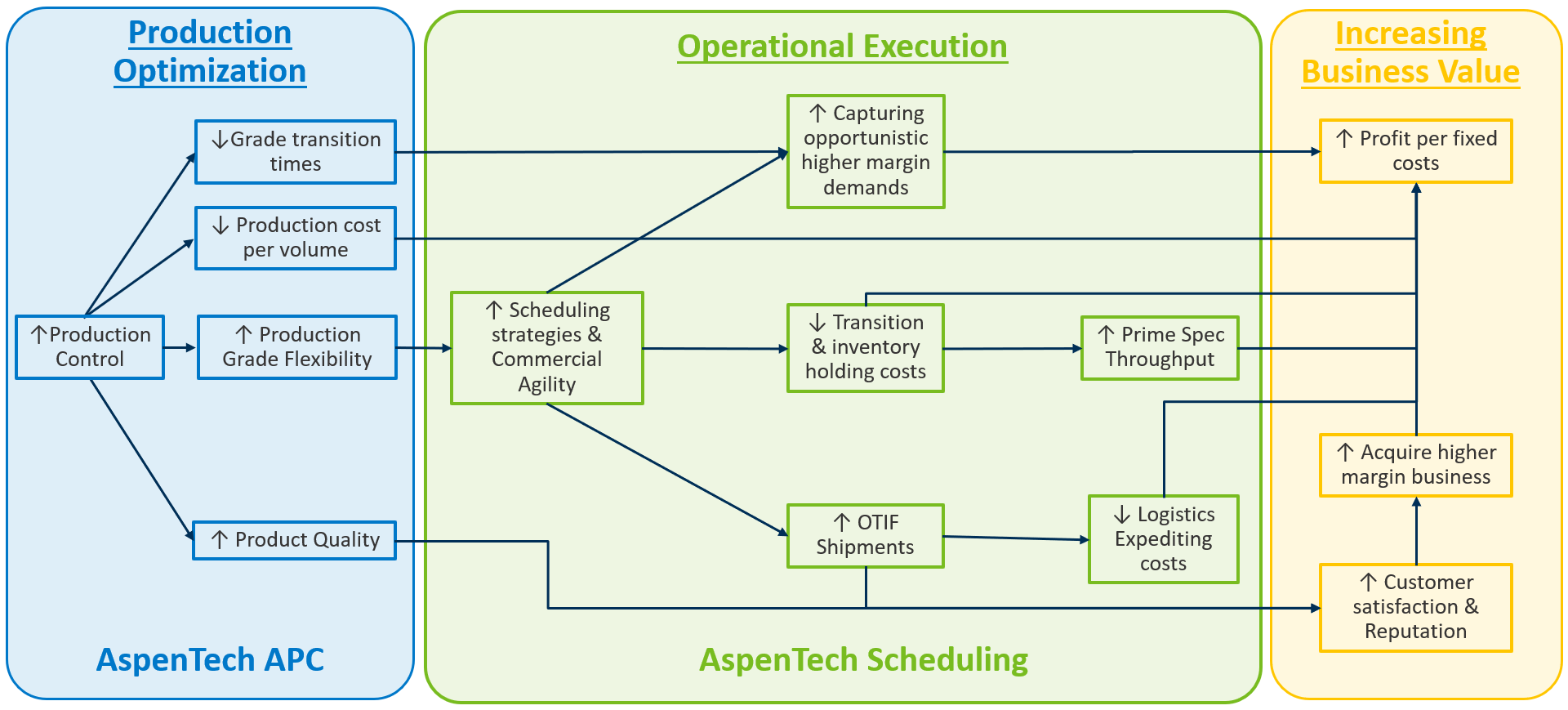Polymers Advanced Process Control (APC) engineers may not be aware that APC benefits can be enhanced via product synergies with production scheduling. Similarly, polymers production schedulers may not be aware that product grade wheel sequencing optimization strategies can be enhanced via product synergies with APC.
What are Product Synergies?
Product synergies are what happens when the combined business value and capabilities of different products are greater than the sum of the separate standalone products. Sometimes, product synergies are also referred to as having a flywheel effect, where improvements in products that are part of a broader business solution help to enhance the performance of other products in that solution.
Aspen APC + Aspen Scheduling = Enhanced Agility and Profitability
As illustrated below, synergies across AspenTech’s APC and Scheduling solutions can create a flywheel effect for polymers producers, resulting in commercial and manufacturing operations agility and enhanced profitability.
/apc-scheduling.png?h=27%25&w=58%25&hash=77CF1380124E673820227EC6F42A3C3E) |
|
Figure 1: Synergies across AspenTech’s APC and Scheduling solutions create a flywheel effect – enhancing profitability and agility
|
Step 1: Polymers Production Control Mastery
The manufacturing of polymers is characterized by many products grades made on shared continuous or semi-continuous equipment. There are two major types of materials that are produced in a polymer reactor: prime-spec and non-prime spec.
Prime-spec is a material that meets the intended product specification. It is sold at a higher selling price than non-prime spec material.
Non-prime spec is a material that does not conform to the intended specification. It is typically sold at a lower selling price than prime-spec material. Things that contribute to the creation of non-prime spec material include reactor operating conditions, excursions and process upsets, as well as product transitions when making one grade of polymers to another in the reactor.
AspenTech DMC3™ and Aspen Process Sequencer benefits include increasing production rates by up to 5%, reducing transition off-spec 25-50%, reducing in-grade off-spec by 50-100%, and increasing catalyst yields by up to 5%.
Step 2: Look to Increase Polymers Production Flexibility
Since polymers grade transitions can take many hours, depending on the reactor residence time (reactor bed turn-over time), the polymers manufacturer’s ability to respond to changing market conditions is limited. With strong production control capabilities in place thanks to Aspen DMC3 and Aspen Process Sequencer, transitions off-spec product is consistently reduced (by up to 50%) and thus the manufacturing operations team becomes more confident in exploring new grade transition options and getting them approved.
More optionality provides more opportunities for the production scheduler to respond to supply/demand changes during the month. Capturing opportunistic volume is often at a price premium when supply is tight in the market. Eliminating low margin transition grades can unlock hidden capacity and is often the most valuable debottleneck opportunity (avoiding Capex).
Step 3: Automatically Calibrate Critical Scheduling Parameters
To close the gap between scheduled production and actual production KPIs, thousands of key scheduling parameters must be calibrated regularly in the production scheduling tool. For polymers manufacturers, this is the data related to grade-to-grade transitions.
For many polymers producers, scheduling models don’t get calibrated often enough – if ever. Schedulers relate stories of making requests to Production or Run-Plant Engineers for assistance, but they are usually busy with other “more important” projects. Reviewing thousands of transition related data assumptions, comparing them to recent actual performance, and calibrating this data in an evergreen manner is extremely tedious work if not assisted with automated analysis and calibration capabilities.
What’s critical to understand is that schedulers are consulted by their commercial colleagues to determine if they can accommodate customer demand inquiries. The production schedule is the basis by which customer orders and delivery expectations are set and managed. Poor data calibration practices related to grade-to-grade transitions needed by the scheduling model results in inaccurate schedules and has knock-on effects related to supply chain and commercial decision making. This means a polymer manufacturers’ ability to proactively manage customer orders expectations is at risk.
Aspen Plant Scheduler™ comes with a synergy capability called “Smart Calibration” which enables quick and easy calibration of the thousands of grade-to-grade transition data when needed. Aspen Plant Scheduler leverages actual grade-to-grade historical performance data stored in Aspen Production Record Manager™, which gets automatically created by the Aspen APC solutions when grade polymers transitions start and end in the reactors.
Steps 4 and 5: Leverage Production Scheduling Sequencing Optimization that will Take Advantage of Production Flexibility
The production schedule is a critical shared asset used to drive alignment across teams at the production facility. The production schedule informs manufacturing of which products (and quantities and in what packaging) they need to make for their commercial teams to sell (the ones customers want to buy). The schedule also gives guidance to manufacturing on the timing and sequence of how/when to make different products. Critically, the schedule is used to control production costs and to maximize profitability.
Polymers schedulers must construct a schedule sequence that considers costly, sequence dependent grade-to-grade transition times and costs. The more grades to schedule, the tougher the task. Unfortunately, to complicate things even further, demand does not materialize in a uniform manner throughout the month (e.g. differing customer order patterns, rush customer orders, spot market demands, seasonality, etc.). Being a scheduler is a stressful and challenging role.
Aspen Plant Scheduler is easy to use and gives back more time to schedulers. AspenTech can help polymers producers quantify the value of improved scheduling by comparing a schedule created by Aspen Plant Scheduler with their existing schedules. Thanks to its automation and optimization capabilities, the solution enables schedulers to improve transition strategies and reduce transition costs by 20-40%, decrease working capital by up to 20%, and reduce late customer shipments by up to 90%. Annualized estimated benefits typically range from $4-$15 per metric ton (example benefits of $800 thousand to $3 million per year for a 200,000 metric ton site) for polymers companies producing upwards of 40 grades. Finally, newfound production flexibility enabled by Aspen DMC3 and Aspen Process Sequencer will be readily taken advantage of by Aspen Plant Scheduler’s “profit hungry” optimizer.
Step 6: Real-time Visibility and Alerts to Schedule vs. Actuals Deviations and Issues
Whenever the schedule is updated, the scheduler publishes it to Aspen Schedule Explorer™ where it becomes immediately visible to everyone. Aspen Schedule Explorer also enables manufacturers to keep a history of past schedules and “tag” (assign keywords or terms) scheduled activities to create a complete picture of “actuals” vs “scheduled” deviations, issues and actions that were being taken at the time they were taken. AspenTech Inmation™, AspenTech’s centralized data management system, can be used to automate critical real-time operations alerts in Aspen Schedule Explorer, enabling agile decision-making in scheduling and execution.
Consequently, manufacturing continuous improvement teams can use business analytics tools to mine the schedule versus actuals “big data” archive contained in Aspen Schedule Explorer to provide quick answers to the questions around “How do we as a manufacturing organization respond when event “X” happens?”
Step 7: Synchronize the Latest Published Schedule so that it can be Leveraged by APC Systems
An actual grade-to-grade transition will typically be scheduled manually by an operator in the control room. In order to do so, they must typically use pull down menus in order to provide three critical pieces of information: (1) the current grade of product that is being made on a specific reactor, (2) the new product to be made, (3) the time when the actual grade transition should be scheduled to start.
Rather than requiring an operator to enter all this information manually, the latest published version of the schedule in Aspen Schedule Explorer can be obtained via web APIs, to pre-populate pull-down menus in the control layer. More automated transition start times, enabled thanks to synchronization with the latest published schedule, will result in less non-prime spec material being produced.
Summary: Synergies across AspenTech’s APC and Production Scheduling Create a Flywheel Effect

Synergies across AspenTech’s APC and Scheduling solutions can create a flywheel effect for polymers producers, resulting in enhanced profitability as well as commercial and manufacturing operations agility. The illustration below provides a map of the cause-and-effect mechanisms across APC and Scheduling that ultimately lead to increased customer satisfaction and differentiated market reputation, leading to an enhanced ability to acquire and retain higher margin business, and increased profits per fixed costs.






Leave A Comment